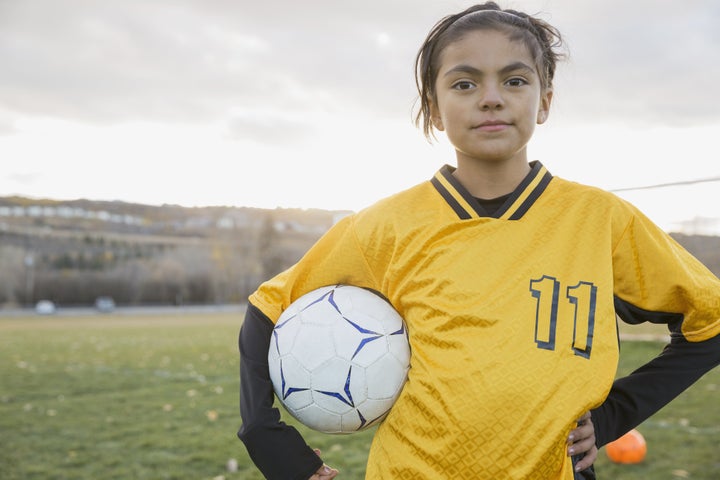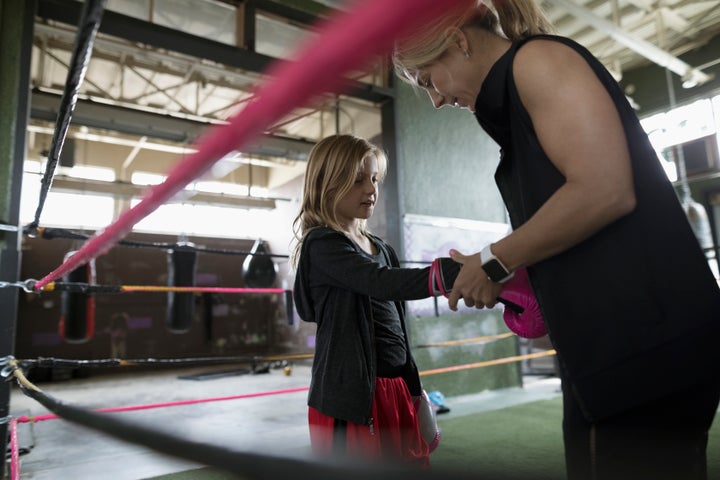But despite this, boys and girls who do participate in sport enjoy it equally, according to an analysis of ′Children’s engagement with the outdoors and sports activities’ by the Office for National Statistics.
They found kids aged eight to 15 in the UK spend just over an hour (68 minutes) of their leisure time taking part in outdoors activity.
“This is the first time ONS has looked at how children are spending their leisure time on sports and outdoor activities,” said senior ONS statistician, Dawn Snape. “Boys spend significantly longer than girls on sport but interestingly, boys and girls who do participate in sport, enjoy it equally.”

One factor that may be encouraging boys to invest more time participating in sports than girls, is that children are more likely to see men in active careers, as women’s events make up only 7% of all sports coverage in the UK.
“Girls need to know sport is for everyone and that their participation matters,” says Siobhan Freegard, editor of parenting site ChannelMum.com.
“Raising up the numbers of girls who take part in sport and the length of time they play it for will have both immediate and long-term benefits in physical and mental health.”
Kate Dale, strategic lead at This Girl Can tells HuffPost UK that fear of judgement is also putting girls off taking up a sport.
“It’s a huge barrier for women – and girls – when it comes to taking up physical activity, which applies regardless of age, size, shape or circumstances,” she says.
“This might sit around ability, being nervous that others will judge them for not being very good; it might stem from appearance, where women and girls don’t want to look hot, sweaty and jiggly while exercising because it’s not an image we see enough in the media; or there may be fear of being judged for their priorities, for being active instead of doing their homework or seeing their friends.”
So how can parents change the ball game and get their girls participating more in sports?
1. Set an example.
“Show your daughter that you exercise and encourage her to join you,” says Freegard. “Even a jog around a local park or an organised family park run is a great start.
Another way to do this is to swap sedentary family activities for more active ones. Rather than going to the cinema, go ice-skating, drive to a bigger, better swimming pool with inflatables or find your local climbing wall or roller disco. This is important, because research shows that by being active themselves, parents, particularly mums, influence their children’s activity levels.
“This doesn’t mean you need to be super-fit and show your children that you’re whizzing between Zumba and Pilates, cramming in as much exercise as possible,” Dale adds.
“It’s equally great if you can show your children that it’s ok not to be the best. That everybody gets hot, sweaty and red-faced, and it’s not the end of the world to take time away from schoolwork or their social life for a little ‘me-time’. The main thing is that you’re having a go, and you’re having fun.”
2. Make it social.
Seek out sporting clubs, classes or activities that may have girls of a similar level and age as your daughter. Or encourage your daughter to take up new classes with friends she already has, to make the experience more social.
“Our research shows girls are most interested in making friends and having fun when playing sport,” says a Women In Sport spokesperson.
A study in Oxford Academic found that the role of friends - whether they also participated in sport or not - was a vital indicator as to whether a teenage girl would themselves participate in sport.
“It appears that the influence of the friendship group is a prominent influence on levels of physical activity for this age group,” the authors concluded.

3. Approach their school with ideas.
Wendy MacLennan, who runs Train Body Brain teaching teenage girls a fusion of fitness and meditation fusion training, believes schools need to prioritise focusing less on traditional sports.
She argues that children who may not be interested in the traditional classes such as football or netball may be put off from sport altogether.
MacLennan suggests parents approach their children’s schools about the issue to see if there are any other sporting activities they would consider including in PE lessons.
4. Don’t underestimate the impact of feeling body conscious.
“Some girls are very body conscious and shy away from sport,” says Freegard. “Let your daughter choose exercise gear or sporting clothes than boost her confidence to get her started.”
In November 2017, research by the Youth Sport Trust and Women in Sport found that a lack of confidence was stopping girls from playing sport. A quarter of girls said they felt insecure, hated other people watching them and didn’t feel confident with the way their bodies looked.
MacLennan said parents should remind their daughters sport is not about feeling bad about yourself, it should be uplifting.
“Ask them what they need or want from a class and what level they want to work at,” she says. “Introduce the idea that any movement in your body is good movement, even if it is a quick walk around the block.”

5. Open up a variety of opportunities.
“Ask girls what sport and physical activity they want to play and give them choices,” advises the Women In Sport spokesperson.
There are hundreds of sports to choose from, so if your daughter isn’t keen on the traditional sports, show her there are other options.
“Your daughter may not want to play a team game but may thrive at individual sports like golf or martial arts,” says Freegard. “Try out several until you find what she’s passionate about.”
MacLennan said High Intensity Interval Training (HIIT) could be a great option for teenage girls because it requires no flexibility, no picking of teams, no specific coordination and “it’s fun”.
Dale suggests seeing what’s happening in your local area: “Encourage your girls to try out a range of options to see what works for them, because we’re all different.”
6. Show your daughters female role models.
“Many women’s sports teams are doing better than the men’s equivalent,” says Freegard. “Seek out strong female sporting role models she can relate too.”
The Women’s Sport Foundation has argued that female athletes “make good role models for adolescent girls by promoting physical activity and involvement in sports, confidence, a strong work ethic, and emphasising the importance of education”.
“These role models show by practicing and spending time honing their craft, they can truly be all that they dream of no matter what their gender, race, or background,” they stated.